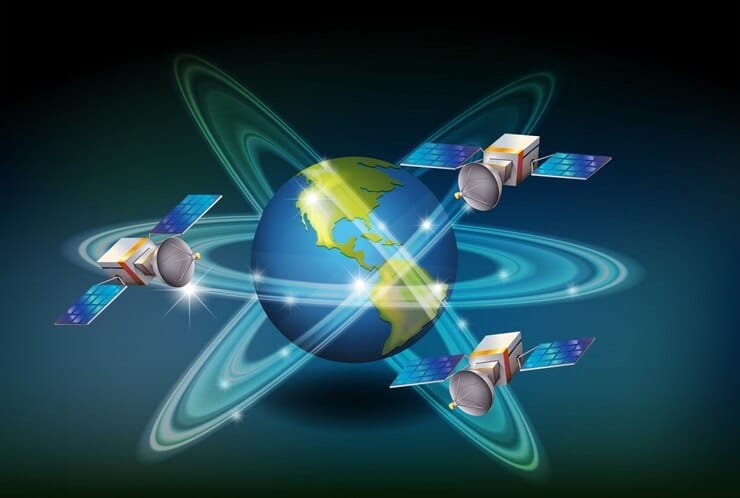Forget pigeon post, folks! We are talking serious advancements in how we transmit bits and bobs around the world. Satellite tech? Unless you mean the dish you used to have at your grandpappy’s house. Those clunky things, a whole lot bigger than your grandma’s prize-winning pumpkin? You know, those are so 20th century.
The equipment behind satellite communication? Rather than “calm before the storm,” it’s more a “tornado of innovation tearing through a field of orbiting gizmos.” We are talking smaller and faster and smarter – satellites that almost think for themselves (well, almost!). And that, chums, is rattling the whole telecom manufacturing establishment like a caffeinated hummingbird in a china shop.
Why would you, the geniuses who invented the magic behind Telecom equipment manufacturing, care? For the reason that world is powered by connectivity! Without satellites, we would have to go back to yelling messages across canyons (and, believe me, my voice is not that strong). We’re talking worldwide access to the internet, instantaneous communication across countries, even important weather predicting that doesn’t involve gazing longingly skyward and just crossing our fingers. It is the backbone of contemporary existence, the data artery pumping bits and bytes to every corner of the globe.
So, buckle up, buttercup! So this is not your typical, run of the mill blog post. We’re splitting up those really juicy details of this seismic shift. Strap in for a wild ride straight to the zenith of satellite tech, where the tech isn’t half as thrilling as the complete overhaul of the telecom manufacturing narrative! Prepare for… launch! (Pun intended, obviously).

Positive Takeaways: Searching for the Stars (and Profits!)
- Miniaturization: Little Is the New Big: Satellites are getting smaller! The idea is lower launch costs, more launches, and a lot more opportunities. Now Companies such as Planet Labs are showing what a multitude of small satellites can achieve — and more importantly, how we can receive that data — delivering daily global imagery! This means opening up more niche markets, lower barriers to entry (for the miniaturization-inclined, of course!, and a whole lotta fun for the entrepreneurs!
- The Birth of the Constellations: Single satellites? So last decade. It’s all about mega-constellations now. A satellite orchestra, for a symphony where all the data plays. Starlink, OneWeb and Amazon’s Kuiper are pioneering this effort in building global broadband access. For equipment manufacturers, it means huge demand for smaller, cheaper and super-reliable components. Get ready for a boom!
- SDE ( Software Defined Everything )Software is eating the world, and satellites are no exception. By utilizing Software-Defined Equipment (SDE), it fosters flexible and adaptive satellite systems, which ultimately speed up innovation and streamline operations. No more messy hardware upgrades… Just like giving your satellite a software update! And it is window to companies who can get the software piece of this tech right, it has a performance advantage and a differentiation.
Discouraging Trends: You can’t beat math.
- Space Junk: Oops! We’ve made a mess up there. That shit in space — dead satellites and debris — is a very real threat to new launches and working satellites. This adds uncertainty and costs for businesses, mandating more advanced collision-avoidance systems and tighter controls. Clean-up efforts (yes, it’s a whole industry that has just been born for that!) are essential to the continued existence of the market.
- Regulation and Licensing: All for One — Nobody Gets it. Global treaties, domestic laws — it’s a freaking minefield! Companies have to be agile and informed in a way to not run into legal issues and potentially costly delays. It’s like really boring paperwork, but in space—the ultimate buzzkill.
- Cyber Cyberthreats: Satellites are increasingly getting susceptible to cyberattacks. Visualize hackers seizing the reins of a communication satellite…yikes! That development requires a considerable investment in effective cybersecurity measures. [8] Businesses have to focus on security solutions in their design and operation continuously to establish trust and credibility.
Actionable Insights: The rocket fuel of success
- Leverage miniaturization: The know-how to make smaller, lighter and more efficient components is there, so invest in R&D work to develop components that can be made smaller and more efficient.
- Master Software Defined Everything: Succeed in satellite software defined technologies.
- Combat Space Junk: Advocate for and support initiatives that focus on removing and/or mitigating space debris.
- 3] Drown out the laws(lawyers) – So, Hire outside help.
Put cyber security first: Make major investments into solutions for satellite security.
So there you have it! This post is from my new site that I’m launching soon. But with a deep knowledge of the trends, a sense of humour and a bit of forward planning, businesses really can not just survive but thrive in this exciting and fast-moving industry. Blast off!
- Health care: Picture a remote clinic in the Amazon. No cell service? No problem! Satellite links carry critical patient information — X-rays, EKGs — to specialists hundreds of miles away. It’s like telemedicine on steroids … or at least really, really strong Wi-Fi. Think of the lives saved! And all the marketing possibilities … “Our diagnoses circle the globe!”
- Technology: Netflix, but for the masses. Really satellite internet is returning and available in high-speed to places fiber optics are afraid to go. Emerging economies also leapfrog with outdated infrastructure; your gear is the rocket fuel. Really ground-based cables, who needs ’em when you can send entertainment (and data) straight from up above?!
- Self-driving cars need constant connection Automotives Particularly those who are testing fleets in remote locations. Satellites supply the constant GPS signal, keeping those robo-taxis from taking unexpected detours… or, you know, driving into a lake. Just think of all the liability issues that don’t have to be dealt with! (Because, let’s be real, someone would sue.)
- Manufacturing: Supply chains are a mess globally. Real messy. Shipments are tracked using satellites, making certain parts get there on time. No more “Where’s my widget?” crises. Think of it as a cosmic-powered delivery-at-a-glance system that is unlike anything you will ever see.
- Maritime/Shipping: We already know boats, ships, tankers are also deployed out there, they too need a continuous communication instrument. Ship navigation and its safety relies on Satellite technology. How much does a lost container ship cost? Astronomical! (Pun intended). That is some very high-priced floating cargo.
- Oil & Gas: Most of the time, remote drilling sites are… remote. Satellites are important for communication and data transmission, monitoring operations, and optimizing efficiency. That’s some serious, well… oil money to earn.
- Agriculture: Satellite imagery is used in precision farming to increase crop yield. Soil health, irrigation needs and pest infestations are gleaned as real-time data for farmers. It’s similar to having a farmhand in space. Prepare for some very lush crops! Or at least, that’s the plan…
- Use case #2: Financial Services: Reliable communication is essential for secure transactions across borders. That backbone is provided by satellites, which keep global financial systems humming right along. Talk about some seriously reliable financial security. No, really, the cash is at stake.
- The bottom line? The satellite was once a thing of the future. They are the now — bringing the unconnected online and energizing business growth as it has never been before. So get out there and make some deals! The sky’s the limit! (Yes, pun intended… but, you know, seriously.)
- Satellite Ground Value Chain Evolving Towards Software-Defined Networking (SDN): There is a Mad Rush in Companies for SDN Implementation in Satellite Ground Henceforth, greener and optimized network configuration which facilitates better bandwidth usage and improved QoS is provided. One of the main providers developed a new ground station controller with SDN capabilities, allowing its customers to serve significantly lower latency and operational costs.
- Improved Security Measures: With satellite comm being a vital part, cybersecurity is of the essence. From 2023, most companies use supervised encryption techniques and detection systems to identify threats on their equipment and software. A manufacturer embedded AI-based anomaly detection in its satellite modems, allowing them to proactively safeguard against cyberattacks.
- Interference by Emerging Technologies: The enhancement of small, light, and economical satellite technology continues to be pursued. This is what companies are enabling with new semiconductor technologies and new designs. One striking example is a new class of small satellite terminals that provide high-throughput performance at a fraction of the cost of existing systems.
- Strategic Partnerships and Acquisitions (Inorganic) Collaborations are key for expanding market reach and technological capabilities. Other companies have linked up with other technology providers with expertise in areas such as AI, cloud computing and cybersecurity. Perhaps most notably was a major satcom operator acquiring a smaller company focused on next-gen antenna tech to expand its products and expertise.
- New Market Development (Organic): Businesses are taking to emerging markets such as the Internet of Things (IoT) and the growing space tourism sector. Which includes offering customized satellite telecommunication solutions specifically designed for those industries. One successful case study is a low-power, wide-area network(LPWAN) satellite system with capabilities to enable massive IoT scale deployments.
- R&D of Next-Gen Technologies: Featuring Next-Gen Technologies Such as Laser Communication and Advanced Processing Techniques, Heavy Investments in Research and Development This would involve investigating high-throughput optical ground stations alongside the role of AI in autonomous network management That was followed by a major R&D investment to develop a new generation of lasercom partners for gigabit data rates by one of the major companies.

Outlook & Summary — Let the Telecom Go Around
So, you just read about how satellite tech is bracing to launch the telecom manufacturing industry into a new stratosphere. Feeling a bit … overwhelmed? Then fear not — we’ll take care of you (with the help of a star quasar of useful insights!).
The next 5-10 years? Buckle up, buttercup! We’re talking a huge shift — a paradigm shift, if you will (we personally love a good paradigm)! Think smaller, more satellites and software-defined everything. So long, cumbersome earth stations – we’re reaching for sleek, chic and unexpectedly cheap satellite solutions. The whole industry’s gonna look like it got a major upgrade from dial-up to 5G … only, you know, space-based.
The key takeaway? Satellite tech isn’t just crashing the telecom party: It’s hosting the party. It’s no longer a niche player — it’s becoming the cool kid everyone wants to hang with. And those old telecom giants? They’re gonna need to learn the constellations real fast or they’ll be stuck circling the earth in a haze of irrelevance. (Ouch!)
The parallel? For example, a rotary phone versus a smartphone. That’s the kind of leap we’re witnessing.” Satellite is delivering the speed, flexibility, and reach terrestrial networks can only hope for.” This is not just about bridging remote areas anymore; it’s also about beefing up existing networks, serving as a backup when terrestrial sources are compromised (natural disasters, cranky squirrels chomping down on wires — we all get it!), and with capabilities never before available.
So, the question is… are you ready to launch yourself into this thrilling new satellite telecom era? Or would you find yourself watching the rocketship from the ground, muttering about the “good ol’ days” of copper wires? The choice is yours — and it’s intergalactic!






